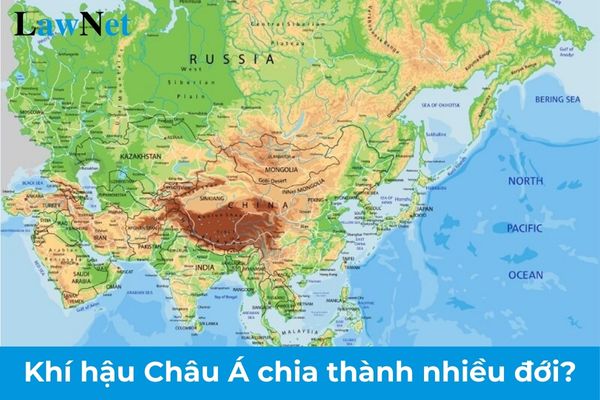Vietnam: Why is Asia's climate divided into multiple zones? How many textbooks will each subject have?
Why is Asia's climate divided into multiple zones?
Asia is the largest continent in the world, with diverse terrain spanning many latitudes, from the icy regions of the North Pole to the hot and humid equatorial regions. Below is a suggested answer to the question "Why is Asia's climate divided into multiple zones?"
| 1. Vast territory stretching from the North Pole to the equator - Asia is the largest continent in the world, stretching from latitude 77° North (the Arctic region) to latitude 1° South (near the equator). - With its vast latitudinal span, Asia experiences many different climatic regions, ranging from polar and subpolar climates in the north, temperate climates in the middle, to tropical and equatorial climates in the south. - This leads to the formation of main climatic zones such as: polar climate, temperate climate, tropical climate, and equatorial climate. 2. Vast territory with many mountain ranges and high plateaus - Asia's vast territory and complex terrain, with high mountain ranges like the Himalayas, Tian Shan, and large plateaus such as Tibet, create barriers to maritime influences penetrating deep into the interior. - This leads to strong climate differentiation within the same zone, forming diverse climate types such as: - Continental climate in central Asia, far from the sea and influenced by wind-blocking terrain. - Monsoon climate in coastal areas of East Asia, Southeast Asia, and South Asia due to the effects of monsoons and the sea. - High mountain climate in areas like the Himalayas and Tibet. 3. Impact of the sea and continent - Asia has many regions far from the sea, particularly the central continental area (e.g., Central Asia). These areas are strongly influenced by the continental climate, with large temperature differences between day and night, summer and winter. - Meanwhile, coastal areas in Southeast Asia and East Asia are influenced by the sea, leading to a monsoon climate with wet summers and cold, dry winters. 4. Impact of pressure belts and monsoons - Asia is influenced by complex pressure belt systems and monsoons. - Northeast monsoon: Active in winter, bringing cold air from the north. - Southwest monsoon: Active in summer, bringing moist air and heavy rain from the sea to the mainland. - This monsoon system is the main reason for the distinctive monsoon climate in Southeast Asia, East Asia, and South Asia. 5. Conclusion The climate of Asia is divided into many climatic zones as a result of the combination of its vast territory stretching from the North Pole to the equator, diverse terrain with mountain ranges and high plateaus, along with influences from the sea, continent, and monsoon systems. These factors have led to distinct climate differentiation across the continent. |
Note: The information is for reference purposes only.

Why is Asia's climate divided into multiple zones? How many textbooks will each subject have? (Image from the Internet)
How many textbooks will each subject in Vietnam have?
Under Clause 1, Article 32 of the Education Law 2019 on textbooks for general education:
Textbooks of general education
1. Textbooks of general education are regulated as follows:
a) Textbooks must implement programmes of general education, concretizing the requirements on educational objectives and contents, on students’ quality and capacity as defined in programmes of general education; direct teaching methods and methods of assessing and evaluating education quality; contents and formats of textbooks shall not carry prejudices based on ethnicity, religion, profession, gender, age and social status; textbooks may be in the printed, Braille or electronic forms.
b) Each subject shall have one or several textbooks; implement private sector involvement in textbook compilation; textbook publication shall be in compliance with the law;
c) Provincial People’s Committees shall decide selection of textbooks for consistent use in institutions of general education in their localities as regulated by the Minister of Education and Training.
d) Local educational materials shall be designed by provincial People’s Committees to meet the needs and characteristics of their localities, be appraised by provincial review councils for appraising and approved by the Minister of Education and Training.
...
Thus, according to regulations, each subject will have one or more textbooks.
What are the requirements on the contents of general education at each level in Vietnam?
Under Clause 2, Article 30 of the Education Law 2019, the requirements on the contents of general education at each level are regulated as follows:
- Primary education must guarantee students the foundation for comprehensive development of physical and emotional health, social skills, simple and necessary knowledge about nature, society and human being; with social moral awareness; with basic skills in listening, reading, speaking, writing and calculating; with habits of physical exercise and hygiene; and with initial understanding of singing, dancing, music and arts;
- Lower secondary education shall consolidate and develop the contents learned in primary education, guarantee students the basic general knowledge in Vietnamese, mathematics, national history, other knowledge in social sciences, natural sciences, law, informatics, foreign languages; with introductory understanding on techniques and career-orientation.
- Upper secondary education shall consolidate and develop the contents learned in lower secondary education, complete the contents of general education. Besides guaranteeing the general, basic, comprehensive and career-orienting knowledge for all students, there shall be advanced teaching in some subjects to develop the students' abilities and satisfy their needs.

